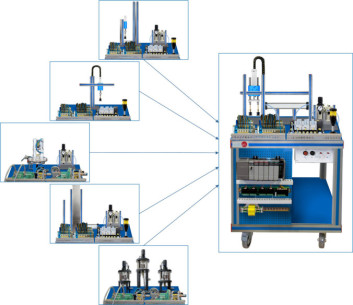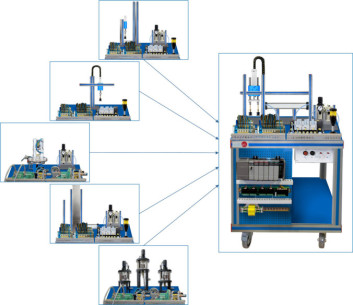The Ball Selection Workstation, "AE-PLC-SLB", designed by EDIBON, allows the study of ball sorting mechanisms using PLC, pneumatic components, and industrial sensors. It facilitates the understanding of positioning, storage, and sorting processes.
The "AE-PLC-SLB" is a ball selection system commanded by a PLC. The workstation detects balls that arrive to the collect position and, according to the color and material, a cylinder guides the balls to the correct container. The system is equipped with different sensors in order to identify the balls.
The "AE-PLC-SLB" workstation is designed as a modular system to facilitate the understanding.
The main components are:
- The PLC: is composed of the CPU unit and all additional modules needed to ensure the correct operation of the workstation.
- The Control Panel: with start/stop button, emergency pushbutton, reset button, light indicators to show the current state of the process, etc.
- The Pneumatic Circuit: contains the required solenoid valves, pressure components, filters, and regulators to ensure the proper functioning of the unit.
- The Workstation: is composed of real industrial components used by rotary table systems such as reed sensors, presence sensors, DC motor, inductive sensors, rotary table with 8 positions, etc.
- The "AE-PLC-MR1" is an independent workstation that can work alone and/or in conjunction with other workstations to form a complete Flexible Manufacturing System*.
The list of products of flexible manufacturing systems is available in the "6.-MECHATRONICS, AUTOMATION AND COMPUMECHATRONICS" area.*
The pneumatic circuit and the workstation are distributed in the following sections:
- Air Treatment System: contains a filter-regulator block with a water trap and shut-off valve to control the air pressure input to the unit. Includes a dual-scale pressure gauge to visualize the pressure level supplied to the unit.
- Parts Feeding Section: contains a sloped ramp for storing the parts. The parts are supplied to the unit one by one through a double-acting cylinder. Each of the two inputs of the double-acting cylinder has an adjustable airflow valve with a bypass to regulate the cylinder speed.
- Parts Verification Section: designed to classify the parts, the four parts with different characteristics will be classified into four storage areas by activating three actuators. The three sorting actuators are double-acting and each has an adjustable airflow valve with a bypass and a pilot-operated check valve to regulate the cylinder speed and block its position in case there is no air input in the double-acting cylinder.
- Parts Sorting Section: designed to classify the parts, the four parts with different characteristics will be classified into four storage areas by activating three actuators. The three sorting actuators are double-acting and each has an adjustable airflow valve with a bypass and a pilot-operated check valve to regulate the cylinder speed and block its position in case there is no air input in the double-acting cylinder.
- Signaling Tower: contains green, yellow, and red LED lights to indicate the system’s status.
- Solenoid Valve Block: it is a distributor block of pneumatic valves with twelve solenoid valves, two of which function as 3/2 monostable solenoid valves, six as 5/2 monostable solenoid valves, and four as 5/2 bistable solenoid valves.
- Electrical Terminal Block: contains all accessible and identified unit signals for manual unit checking. The electrical terminal block has color-coded terminals to help the user identify the type of each signal, and it also contains the name of each signal.
 Préférences sur les cookies
Préférences sur les cookies











